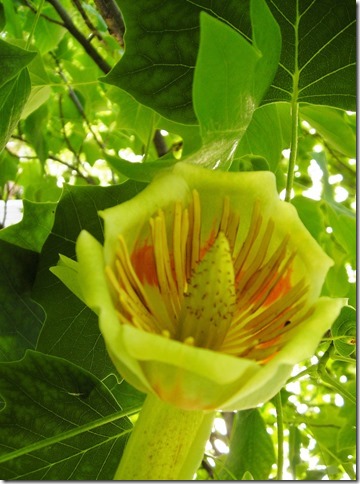Martie Young
Adams County Master Gardener

When early settlers arrived in America, they encountered many old-growth forests filled with trees that had stood for centuries. Among them was the Tulip Tree or Yellow Poplar. Massive and straight, supporting a crown of foliage often lost to sight high above the canopy of its lesser neighbors, a giant tulip tree might be 200 feet tall. No other
broadleaf trees in eastern North America grew so tall.
Even though these massive trees are gone, the tallest one left stands in Bedford, Virginia at 146 feet, area residents have the opportunity to glimpse one of these impressive trees growing in the Myers Arboretum right here in Hanover.
The American Tulip Tree is a wonderful specimen for the forest or a large property. It deserves plenty of room to show off since it can grow up to 90 feet over a 50 to 100 year period. If you happen to see it in a forest setting, you may recognize it by its extremely straight trunk. With its canopy of leaves towering over other forest trees, its
exotic tulip-shaped flowers are often sadly overlooked. They are among the most beautiful flowers produced by any tree.
The tree begins to show flowers at about 15 years of age, and luckily when the branches are low enough for flowers to be observed. Another way to see them is when they fall to the ground and reveal their exotic features. They are large flowers, usually larger than tulip flowers themselves. Their colors include celadon green, orange, yellow and
gold. The inside of the flower has an intricate circle of match-sized stamens surrounding a central cone-like pistil. When the petals fall, the pistils remain on the tree where they can be seen till autumn.
 The flower shape makes it very easy to attract bees that will pollinate and produce possibly a tablespoon of nectar per flower. The nectar contributes to the rich and strong flavor of poplar honey. Hummingbirds, too, find it easy to get nectar from
Tulip Tree blossoms. The tree is also a primary larval host to several moth and butterfly species. Black swallowtails and eastern tiger swallowtails are the most easily identified species that utilize this tree. A two-inch moth with a mottled pattern of white, gray and black called Tuliptree Beauty (Eppimecis hortaria) prefers Tulip Trees as its larval host which is the
caterpillar stage of the butterfly and the moth.
The flower shape makes it very easy to attract bees that will pollinate and produce possibly a tablespoon of nectar per flower. The nectar contributes to the rich and strong flavor of poplar honey. Hummingbirds, too, find it easy to get nectar from
Tulip Tree blossoms. The tree is also a primary larval host to several moth and butterfly species. Black swallowtails and eastern tiger swallowtails are the most easily identified species that utilize this tree. A two-inch moth with a mottled pattern of white, gray and black called Tuliptree Beauty (Eppimecis hortaria) prefers Tulip Trees as its larval host which is the
caterpillar stage of the butterfly and the moth.
In my opinion, the Tulip Tree ‘s flower is its best feature. However, the tree does has practical uses. Since the trunk is so long and straight, its lumber is used for flooring, siding, furniture and fencing. In past times, its wood was used by early Pennsylvanian German settlers to construct furniture, especially the beautiful chests,
cheerfully-painted kitchen chairs and utilitarian cupboards that can sometimes be found in homes and antique shops in our area. Because the Tulip Tree’s wood is rather plain but easy to work and free of knots and blemishes, these early immigrants used it, painting their furniture in fanciful colors and designs which were part of the Germanic tradition they brought with
them when they came to America.
Some animals may nibble on the wood, and birds use the trees for shelter. These trees provide generous shade and a high canopy for parks and picnic tables. They have been planted as street trees, but they have little resistance to pollution and soil compaction and their branches are subject to breakage. Aphids are sometimes a problem.
In our area the Tulip Tree should be blooming around the end of May. The specimen at the Myers Arboretum in Hanover has flower buds which will soon be blooming. The tree is still young so the branches are low enough for visitors to see the flowers up close and observe the leaves which have a unique shape, too.
The Arboretum is located in Doss Alley in Hanover, directly behind and across the alley from the Warehime-Myers Mansion at the corner of Hanover and Baltimore Streets. There is parking in the alley and a gate close to the parking. To find the tree, open the gate and walk straight across to the next alley where the tree is located in the
northeastern corner in rather an open setting. While there, take the time to view all the other large trees in the Arboretum.
Read other articles about tree care
Read other articles by Martie Young